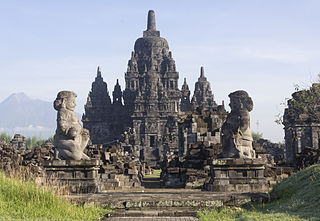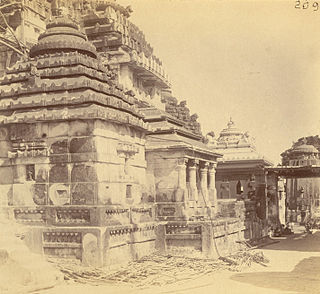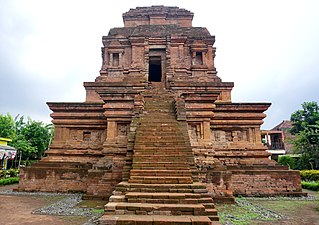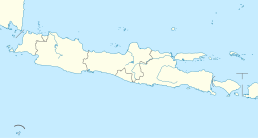
Prambanan is an 8th-century Hindu temple compound in Special Region of Yogyakarta, Indonesia, dedicated to the Trimūrti, the expression of God as the Creator (Brahma), the Preserver (Vishnu) and the Destroyer (Shiva). The temple compound is located approximately 17 kilometres (11 mi) northeast of the city of Yogyakarta on the boundary between Central Java and Yogyakarta provinces.

Kalasan, also known as Candi Kalibening, is an 8th-century Buddhist temple in Java, Indonesia. It is located 13 kilometers (8.1 mi) east of Yogyakarta on the way to Prambanan temple, on the south side of the main road Jalan Solo between Yogyakarta and Surakarta. Administratively, it is located in the Kalasan District (kapanewon) of Sleman Regency.

A prang is a tall tower-like spire, usually richly carved. They were a common shrine element of Hindu and Buddhist architecture in the Khmer Empire (802-1431). They were later adapted by Buddhist builders in Thailand, especially during the Ayutthaya Kingdom (1350–1767) and Rattanakosin Kingdom (1782–1932). In Thailand it appears only with the most important Buddhist temples.

A candi is a Hindu or Buddhist temple in Indonesia, mostly built during the Zaman Hindu-Buddha or "Hindu-Buddhist period" between circa the 4th and 15th centuries.

7°37′38″S111°7′52″E

Sewu is an eighth century Mahayana Buddhist temple located 800 metres north of Prambanan in Central Java, Indonesia. The word for a Hindu or Buddhist temple in Indonesian is "candi," hence the common name is "Candi Sewu." Candi Sewu is the second largest Buddhist temple complex in Indonesia; Borobudur is the largest. Sewu predates nearby "Loro Jonggrang" temple at Prambanan. Although the complex consists of 249 temples, this Javanese name translates to 'a thousand temples,' which originated from popular local folklore. Archaeologists believe the original name for the temple compound to be Manjusrigrha.

7°45′41.49″S110°28′27″E

Prambanan Temple Compounds is the World Heritage designation of a group of Hindu and Buddhist temple compounds that lie on the border between Yogyakarta and Central Java, Indonesia. It comprises Prambanan, Lumbung, Bubrah and Sewu temple compounds, all are located within Prambanan Archaeological Park.

7.7625°S 110.4469°E

Gebang is an 8th-century Hindu temple located on the outskirts of Yogyakarta, Indonesia. The temple is located at Gebang hamlet, Wedomartani village, Ngemplak, Sleman Regency, Special Region of Yogyakarta. The temple was built during the Medang Kingdom.

Banyunibo is a 9th-century Buddhist temple located in Cepit hamlet, Bokoharjo village, Prambanan, Sleman Regency, Yogyakarta, Indonesia. The temple, dating from the era of Medang Kingdom, sits in a narrow valley surrounded by paddy fields about two kilometers southeast of the Ratu Boko archaeological park on the east side of modern Yogyakarta. Further north is the Prambanan temple, and to the south are the Gunung Sewu hills, extension of Gunung Kidul hills.

Sojiwan is a 9th-century Mahayana Buddhist temple located in Kebon Dalem Kidul village, Prambanan, Klaten Regency, Central Java. The temple is located nearly two kilometres southeast of Prambanan temple. This temple is among numbers of temples scattered in Prambanan Plain.

7°44′6″S113°28′18″E

The Vimala Temple or Bimala Temple is a Hindu temple dedicated to goddess Vimala (Bimala), located within the Jagannath Temple complex in Puri in the Indian state of Odisha. It is generally regarded as a Shakti Pitha, among the holiest temples dedicated to the Hindu Goddess.

7°39′45″S112°40′11″E

Ijo temple is a Hindu candi (temple) located 4 kilometers from Ratu Boko or around 18 kilometers east from Yogyakarta, Indonesia. The temple was built between 10th to 11th century CE during the Mataram Kingdom period.

Ngawen is an 8th-century Buddhist temple compound in Magelang Regency, Central Java, Indonesia. Located in Ngawen village, Muntilan sub-district, 6 km (3.7 mi) to the east of Mendut temple or 5 km (3.1 mi) to the south of Muntilan town center. Ngawen temple compound consists of five temples, however today only one is successfully reconstructed.

Gunung Gangsir is an 11th-century Hindu candi (temple) located approximately 5 kilometers west from the town of Bangil. This red brick structure is located in Gunung Gangsir village, Beji subdistrict, Pasuruan Regency, East Java Indonesia.

Badut is an 8th-century Hindu candi (temple) located in Tidar area around 5 kilometres west from the center of Malang city. This andesite stone structure is located in Karang Besuki village, Dau subdistrict, Malang Regency, East Java Indonesia.
Bumiayu temple compound, or locally known as Candi Bumiayu, is a Sumatran Shivaist Hindu temple complex located near the banks of Lematang river, precisely in Bumiayu village, Tanah Abang district, Penukal Abab Lematang Ilir Regency, South Sumatra, Indonesia. The temple located about 120 kilometres west of Palembang city. The red brick structures are estimated dated from 8th to 13th-century, and linked to the Srivijaya kingdom. Compared to Java, only a few Hindu-Buddhist temple ruins has been rediscovered in Sumatra. The temple is known as one of the few surviving Hindu temple remnant in South Sumatra. Other temple ruins in Sumatra are Muaro Jambi in Jambi, Muara Takus in Riau, and Bahal temple in North Sumatra.
























